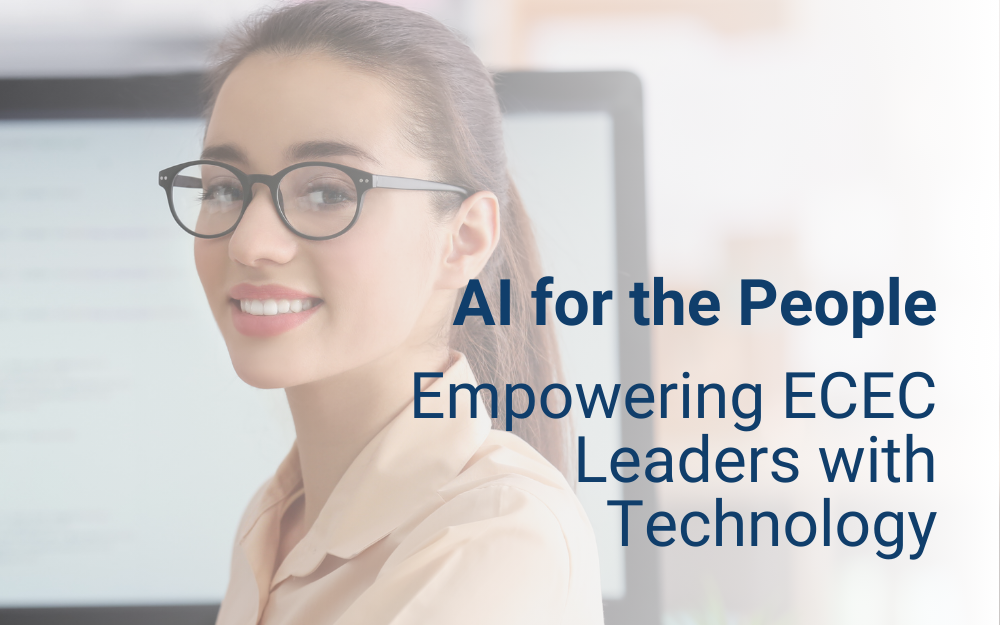AI in early childhood education: Green lights, red flags, and worlds of opportunity
The advent of artificial intelligence (AI) has been a ‘game changer’ in many sectors and industries, and in education specifically, there is expected to be a $20 billion market for AI by 2027.
From streamlining administrative tasks through to supporting data analysis and decision making, there is a powerful case for the use of AI to help businesses of all types – including early childhood education and care (ECEC) to solve problems and support high quality practice.
As technology continues to advance, ECEC services are adopting AI solutions to enhance their services, improve safety and promote efficiency.
AI, when used with consideration, has the potential to be a powerful problem-solving tool.
What are some of the common ECEC problems that AI can solve?
Automating simple tasks: AI has the function and capacity to respond to simple enquiries from parents to questions about enrolment, vacancies on any given day, opening hours, and many other functions, freeing up the time of educators and leaders to allow them to work directly with the children, and to refine pedagogy and practice.
Supporting staff with compliance: Some ECEC services, like Guardian Childcare and Education, are using AI to support their educators while working directly with children, guiding them through policy and practice with the use of the chatbot tool ‘Ask Guardian Way.’
The AI driven tool enables educators to receive immediate, accurate answers to policy-related questions, with the provider saying that since its introduction it has dramatically enhanced educator efficiency and confidence.
Billed as being “the definitive guide to the Guardian way of operations,” the chatbot aligns seamlessly with the company’s policies and procedures, fostering a culture of accessibility and efficiency.
Finding better options: Other services have embraced AI to set themselves up for success, right from the start. Before Futuro began offering education and care, they engaged with the team at Daitum to harness the power of AI to optimise staffing prior to opening, and then to manage rostering for its 35 staff and 141 children.
Once Futuro was up and running, Daitum’s solutions were easily able to adapt to fluctuating occupancy rates and staff availability, automatically factoring in qualification requirements for each shift to ensure compliance with regulations.
Not all AI is created equal
Some ECEC services are reluctant to engage with AI, fearing that it will be too complicated to understand, or that the technology is changing and evolving too quickly to keep up with.
It is important to understand that there are many facets to AI, which includes narrow AI, generative AI and conversational AI to name a few.
Narrow AI doesn’t ‘learn’ like some other types of AI does, but instead follows pre-programmed rules, or learns patterns in other data.
In simple terms, narrow AI is designed to perform tasks that normally need human intelligence, operating under a limited set of constraints, and is task specific.
Generative AI learns from other data, and uses that data to make new data, following the rules and patterns that it has learned.
For example, if you gave generative AI pictures of bicycles, it would learn that a bicycle is something with two wheels and a seat, and would then be able to generate its own pictures of bicycles, coming up with multiple variations, all while still following the basic rule of ‘two wheels and a seat makes a bicycle.’
Conversational AI is intelligent software that uses natural language processing (NLP), machine learning (ML) and other AI technologies to understand, process and respond to human language.
The chatbot software which responds to parent enquiries on a website is an example of conversational AI.
Daitum’s rostering software uses narrow AI to look at the data behind rostering – how many Diploma qualified staff are needed? How many ECTs? Who works full time? Who works part time? Who is on leave this week? When do the bulk of the children arrive? What time do they leave? – and responds by creating ‘data’ of its own (in this case, a fully compliant roster), taking rostering time from two or more hours of manual roster creation down to just minutes.
People focused problems need people centric solutions
First and foremost, Daitum is focused on people – helping people in ‘helping’ sectors like ECEC to get time back to do what they do best – caring for others.
Building great rosters helps leaders to be on the ground, assisting and supporting those in early childhood to bring their best selves to work every day, educating and caring for Australia’s youngest learners.
Far more than just ‘data learning from data’, Daitum’s powerful rostering tools are a way to give leaders back the one thing they need most – time.
There are other benefits too, such as removing allegations of bias or favouritism when it comes to shift allocations, or reducing the cost spent on last minute agency staffing to fill rostering gaps.
Would you like to learn more about how Daitum can support your service with compliant rosters? Contact Dean Paquola on dean.paquola@daitum.com, or click here to learn how leading childcare centres across Australia are using AI to optimise their rosters and drive growth and efficiency.
Read how Futuro is saving more than 10 hours a week on rostering, eliminating overstaffing and avoiding unnecessary wage expenses. Click here to access the Case Study
Read how Guardian Childcare is achieving 8% fewer hours rostered a week, having fully compliant rosters and saving up to 4-12 hr per week rostering. Click here to access the Case Study
– This is one of a 3 part series designed to help childcare providers get the most of out their technology investments. Part 2 will focus on preparing your organisation for success, and part 3 will share how to embed these improvements for the long term. –

